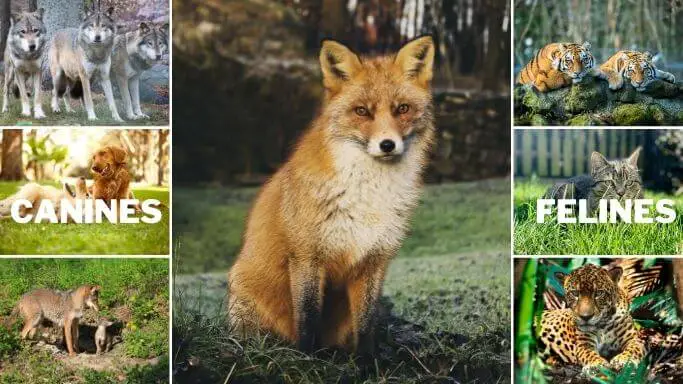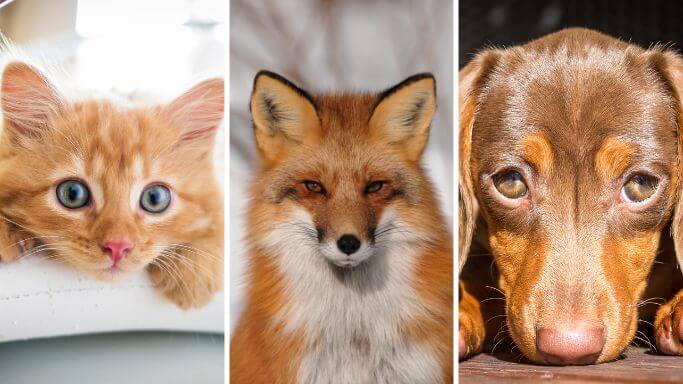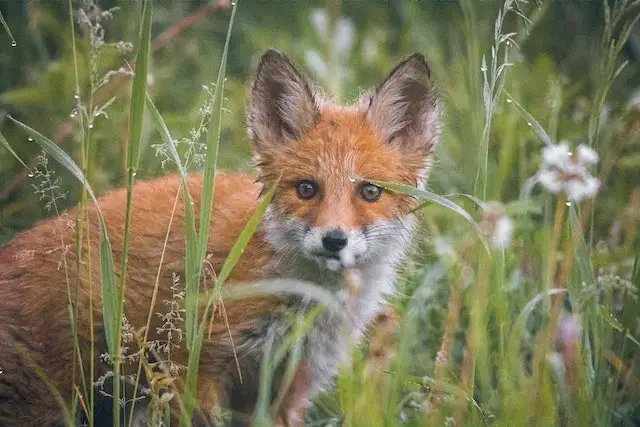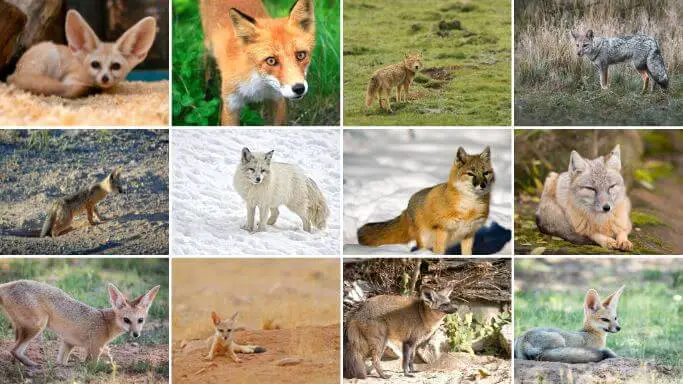
Some call them canines, and some call them candids, and what’s interesting is that their family is extensive to include species that are as tame and faithful as the dog to the clever and cunning fox.
And if you have landed on this page, it is this second animal that you have come to learn about, wanting to know whether he falls into this category or not.
Right now, the question on your mind is, are foxes canines or felines, right? Read on to see which category they fall into and why.
Are Foxes Canines Or Felines?
Foxes are canines, not felines. Because they belong to the Canidae family of animals. Canines are characterized by their slender build, long legs, bushy tails, and long muzzles.
The key feature that identifies a canine family member is the teeth for which they are named.
And so, here’s a table with some information you can take in, understand and see, after which you will see a few more things to justify the answer you get in the end.
| Characteristics | Canines | Felines | Foxes |
| Family | Canidae | Felidae | Canidae |
| Genus | Canis (e.g., wolves, dogs) | Felis (e.g., cats) | Vulpes (e.g., red fox) |
| Teeth | 42 teeth | 30 teeth | 42 teeth |
| Diet | Omnivores/Carnivores | Obligate Carnivores | Omnivores |
| Hunting | Pack hunters | Solitary hunters | Solitary hunters |
| Vocalizations | Barking, howling | Meowing, purring | Barking, screaming |
| Gait | Trotting, running | Stalking, pouncing | Trotting, running |
| Climbing | Limited climbing ability | Excellent climbers | Limited climbing ability |
| Domestication | Commonly domesticated | Commonly domesticated | Rarely domesticated |
As you see, foxes are carnivorous, but a lot of canine species are omnivores. However, despite all this, foxes resemble cats with their cunning ways. And this is why they are often referred to as feline dogs.
Are Foxes Closer To Dogs Or Cats?

Foxes are closer to dogs. They look like cats, but don’t let this get you deceived. Consider the information in the table below, and you are sure to agree.
| Characteristic | Fox | Dog | Cat |
|---|---|---|---|
| Classification | Mammal, Canidae family | Mammal, Canidae family | Mammal, Felidae family |
| Appearance | Pointed nose, bushy tail, upright ears | Various sizes, floppy or upright ears | Pointed ears, sleek body, retractable claws |
| Size | 45-90 cm (18-35 in) length | Varies, 20-76 cm (8-30 in) height | 46-51 cm (18-20 in) length |
| Weight | 3-14 kg (6.5-30 lbs) | Varies, 2-80 kg (4-180 lbs) | 2.5-7.5 kg (5.5-16.5 lbs) |
| Habitat | Forests, grasslands, deserts, and mountains | Domesticated, various environments | Domesticated, various environments |
| Diet | Omnivorous, small mammals, birds, insects, fruits | Omnivorous, primarily meat-based diet | Carnivorous, primarily meat-based diet |
| Behavior | Solitary, nocturnal, territorial | Social, diurnal, trainable | Solitary, crepuscular, territorial |
| Lifespan | 3-14 years in the wild | 10-13 years | 12-15 years |
So, you see, they belong to the family of dogs, have sharp upright ears like dogs, and are omnivorous, like dogs. Perhaps the only difference is that they can’t be domesticated like dogs. Yet, they can’t be tamed like the cat too.
If you want to know more, check out this article for more details on whether are foxes closer to dogs or cats.
Foxes Vs. Cats: Similarities & Differences
Many mistake the fox for belonging to the family of cats, and who can blame them, considering their many similarities, which are many in contrast with the differences.
Similarities
Here goes the fox and the cat and all their similarities.
- Poise: Foxes, like cats, have a sense of elegance, making them more feminine than the dog. Watch them stretch, and you will agree.
- Climbers: Both of them can climb trees and this, too, with ease. They can jump too, and with their retractable claws, they find their way over walls and fences with difficulty.
- Hunters: Foxes, like cats, are hunters with the same hunting techniques, including stalking, running, and then pouncing.
- Whiskers – Foxes, like cats, have whiskers, and so even with the snout, they have a face that looks very much like the cat, cute and deceiving.
- Eyes: Foxes have an optical structure similar to cats; they have vertical pupils which narrow to slits and a reflective membrane at the back of their eye.
Differences
And now for the differences. The variations between the two are quite significant.
- Diet: If a fox is kept on a meat-only diet, he will soon go blind, so his food is not all that he preys on by hunting.
- Sleep Patterns: While it is true that cats love to nap all day, they take their rest at night too. In other words, unlike the fox, they are truly lazy, which is more nocturnal.
- Grooming: Cats love to groom themselves and look good to their owners. So, they are busy licking themselves when not sleeping or playing with you. A fox is dirty and smelly.
- Claws: They both have strong, spongy, and flexible claws. The only physical difference in their claws is the claws of foxes are a little bit large and stiffer than cats.
Must Read: Are Bears Closer To Dogs Or Cats?
Foxes Vs. Dogs: Similarities & Differences
Foxes and dogs have more similarities than differences, and yet the fox is much more different from the dog. Why so? Read this short list of similarities and differences, and by then, you will know.
Similarities
Let’s begin with the similarities, which, to be honest, is not much.
- Snout: This is one of the most glaring differences between the fox and the dog. Observe the fox and observe the dog. You will see that they both have snouts. And with these snouts comes an excellent ability to smell.
- Ears: You saw that both the fox and the dog have large ears, and a good sense of earrings comes with that.
- Overall Anatomy: In general, this is all that a fox and a dog have in common, with the most glaring similarity being the snout and the ears.
And then, the similarities end there. Now coming to the differences.
Differences
The differences, though only a few, can make a lot of difference. Read on to know what this means.
- The Snout Again: The fox’s snout is more narrow, giving them more of a cat-like appearance. On the other hand, dogs have snouts that are more rounded.
- The Tail: Unlike the dog, the fox has a much bushier tail, which mainly carries horizontally, unlike a dog known to keep it upright and wag it at those he likes. And that brings us to the most critical difference between the dog and the fox.
- Domestication: Finally, here comes the main difference. The characteristics of a dog make him pleasant to domesticate, but not so does the fox. Foxes have a much shorter attention span.
Therefore, foxes and dogs are both members of the Canidae family, but they belong to different genera. Dogs belong to the Canis lupus familiaris species, whereas foxes belong to various species within the Vulpes genus.
Why Do Foxes Act Like Cats?

The similarity in traits between foxes and cats is due to convergent evolution. This means that these animals have independently evolved similar traits as a result of having to adapt to similar environments or ecological niches.
Like cats, they quickly climb trees and move around with a cat-like elegance and poise. They can stalk, run and pounce, all common to cats.
They also have sharp claws, which they use to subdue their prey. Like cats, they are good hunters that can go after their target.
Why Do Foxes Have Cat Eyes?
Foxes have eyes that are similar to cats because they have adapted to function efficiently in both day and night environments.
As a result of similar environmental demands, this type of eye adaptation allows foxes to move rapidly between obstacles when hunting or running.
Those split pupils are another prominent feature that makes a fox look like a cat, only much scarier.
And it is not just their eyes. Observe the area around the snout, and you will notice that the fox comes with whiskers, too, so nobody can blame you if you mistake it for belonging to the family of cats.
Can A Fox And A Cat Breed?

Okay, the truth is that the fox and the cat do not come for the species, so the answer to the above question is no. Foxes and cats cannot breed.
As they belong to two families, both animals have different chromosomes and cannot produce viable offspring.
A fox has about 78 chromosomes, while a cat has 38. So, how can the two of them mate and breed?
Can A Fox Breed With A Dog?
This, too, is highly impossible as, again, the two animals do not share the same set of chromosomes.
Chromosomes are structures in a cell that provide genes to determine the physical traits of a living being, and for two animals to breed, they need to be the same.
The dog and the fox have different genetic materials, making it impossible to develop a hybrid of the two.
How Are Foxes As Pets Compared To Dogs And Cats?

Can I have a pet fox? Isn’t that a question on your mind? The truth here is that despite their similarities to the two animals mentioned above, a fox cannot be domesticated, which means they do not make good pets.
They are highly energetic, very particular about their territory, and much louder than a dog that can be silenced.
So, adopt a fox at your own risk, as you will have a hard time with the neighbors around.
How Big Can Foxes Get, Compared To Other Canines?
This mainly depends on the breed of the fox. For instance, you have the red fox that can grow as long as about 40 inches (if you measure from the head to the tail) and weigh about 11 to 15 pounds.
But then, you also have fennec foxes that are generally small, growing up to just eight inches and weighing about two to three pounds.
Foxes are much smaller than coyotes, wolves, and even the dog. So, to sum up, foxes with their slender bodies, and all are much smaller than the other canines.
Types Of Foxes: How Many Species Of Foxes Are There?

Oh, there are many of them, and you’ll be surprised to see the list. Briefly, there are about 37 fox species, but only 12 are considered true foxes. They’re in the “Vulpes” branch of the Canidae family. Here’s a quick summary of each.
1. Fennec Fox: This small fox can survive in the Sahara too. He has ears that are half as long as his body to help him adapt to the heat. Added is the thick fur to protect the solitary hunter from the hot sand.
2. Red Fox: This is the largest of the lot and is mainly found in the Northern Hemisphere. However, he is highly adaptable and can be made to live in different habitats, which is why you have diverse species of his kind.
3. Tibetan Sand Fox: As the name suggests, this one is found in the Tibetian plateau and is rather unusual. He likes the cold, rocky environment and has a thick coat to protect himself from the winter chills. Unlike most other foxes, he is more active during the day.
4. Grey Fox: He likes the woody, bushy, rocky habitats and is found in North and Central America. The grey fox is unique and can climb trees like a cat.
5. Kit Fox: This one lives in the desert and is also very small. Yet, he is tough and can withstand even the most scorching heat. He is more active at night and cools himself in the den during the day.
6. Arctic Fox: As the name suggests, he is large and demanding and lives in the Arctic region, so he is often referred to as the polar fox. He has a thick layer of fat and fur to beat the cold.
7. Swift Fox: This one is small but swift, so much so that he can cover 60 kilometers an hour. This means he can escape predators, but his prey cannot escape him. He is smaller than the regular cat and is mainly found in North America.
8. Corsac Fox: This one comes in a medium size and is mainly found in Asia. He is unusual and lives more of a migratory lifestyle. His talent is to hunt down the deer, especially in the winter, by following its footprints in the packed snow.
9. Cape Fox: As the name suggests, this one is mainly found in Africa and is fond of hunting down rodents. He has sharp ears that can detect their sound even underground. He also feeds on plants and other vegetables.
10. Bengal Fox: He is also known as the Indian fox and is mainly found in East India. He has a long and bushy tail about half his body length. He uses this to run. He lives in protected areas and likes to hunt alone.
11. Blanford’s Fox: Known as the Afghan Fox, found mainly in the hills and mountains of Afghanistan and surrounding areas. Despite his size, he is an excellent climber with sharp claws that give him a good grip. He is a solitary forager and eats small mammals, insects, some fruits, and plants.
12. Ruppell’s Fox: This species is native to North Africa and the Middle East. Sand-yellow fur with black patches distinguishes this small fox species. Rüppell’s Fox is classified as near threatened by the IUCN due to habitat loss.
Never imagined seeing such a vast list, did you? And there sure are a lot many names here that are new to you. Well, that’s how many breeds of true foxes exist in the world.
Recommended Reading: Are Hyenas Closer To Dogs Or Cats?
Frequently Asked Questions
Q1. Is any fox a feline?
Ans: No, foxes are canines belonging to the Canidae family. They’re unique from both dogs and cats, possessing their distinct features and behaviors.
Q2. Are foxes and wolves related?
Ans: Yes, foxes and wolves are related, as they both belong to the Canidae family. However, they’re separate species with different hunting techniques and habitats.
Q3. Are foxes dangerous?
Ans: Generally, foxes avoid humans. Although they pose a minimal threat, foxes may carry diseases or parasites, so it’s best to avoid close contact.
Q4. Do foxes have retractable claws?
Ans: No, foxes have semi-retractable claws, which provide grip while climbing and help in pouncing on their prey.
Q5. Are foxes carnivores or omnivores?
Ans: Foxes are omnivores, consuming a varied diet, including rodents, insects, fruits, and vegetables, to fulfill their nutritional requirements.
Q6. How long do foxes live?
Ans: In the wild, foxes have a lifespan of 3-4 years. However, in captivity, they can live up to 14 years, provided they receive proper care and nutrition.
The Verdict: Are Foxes Canines Or Felines?
So, that was a lot about foxes that you read today. Now how about answering your question?
And the verdict that goes is foxes are canines that look like felines. Shouldn’t that be obvious, considering this animal always tries to deceive us?
And that’s how the fox deceives the rest of the world, with his feline ways, like a lazy cat. But beneath the feline exterior is a wild and energetic canine.

